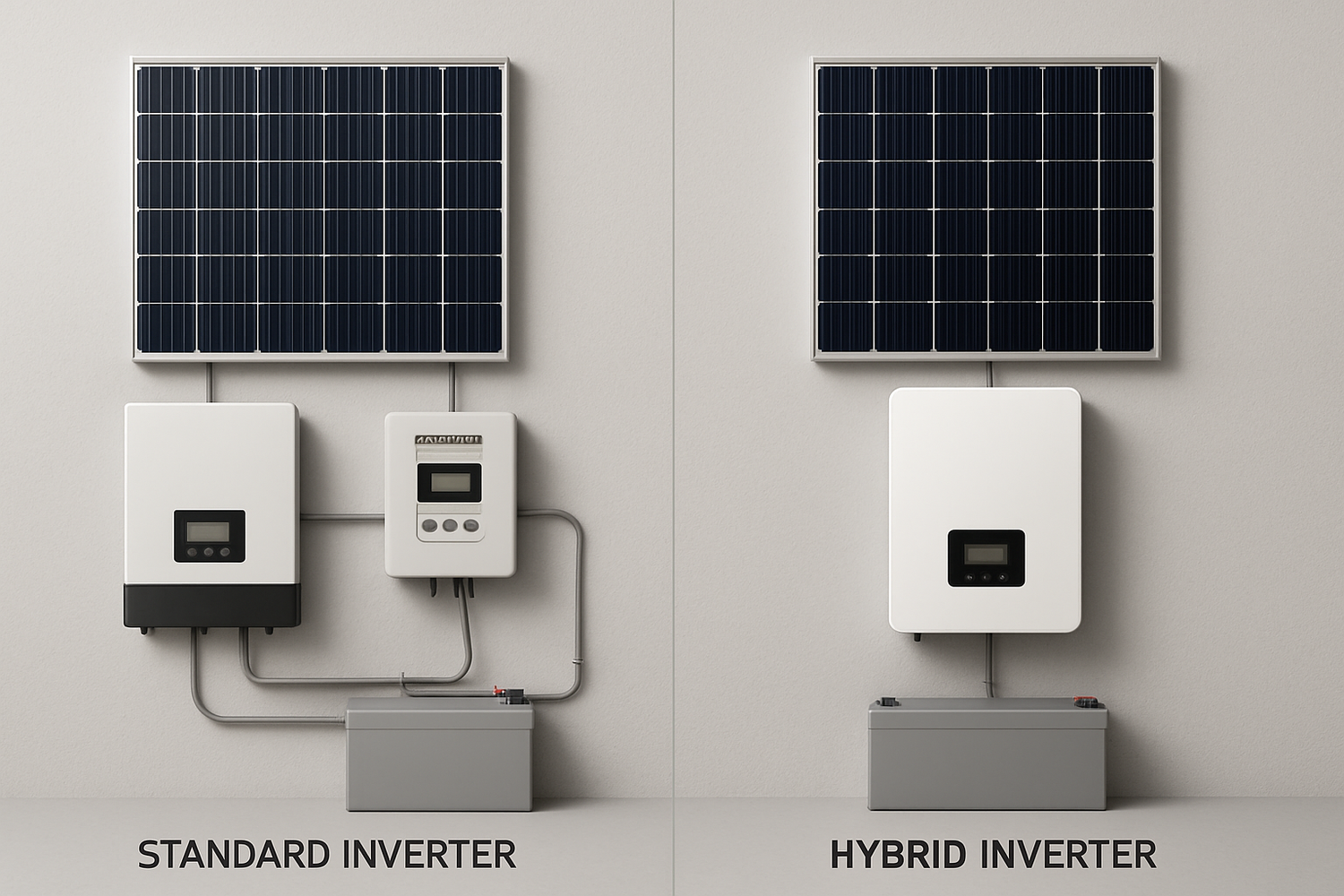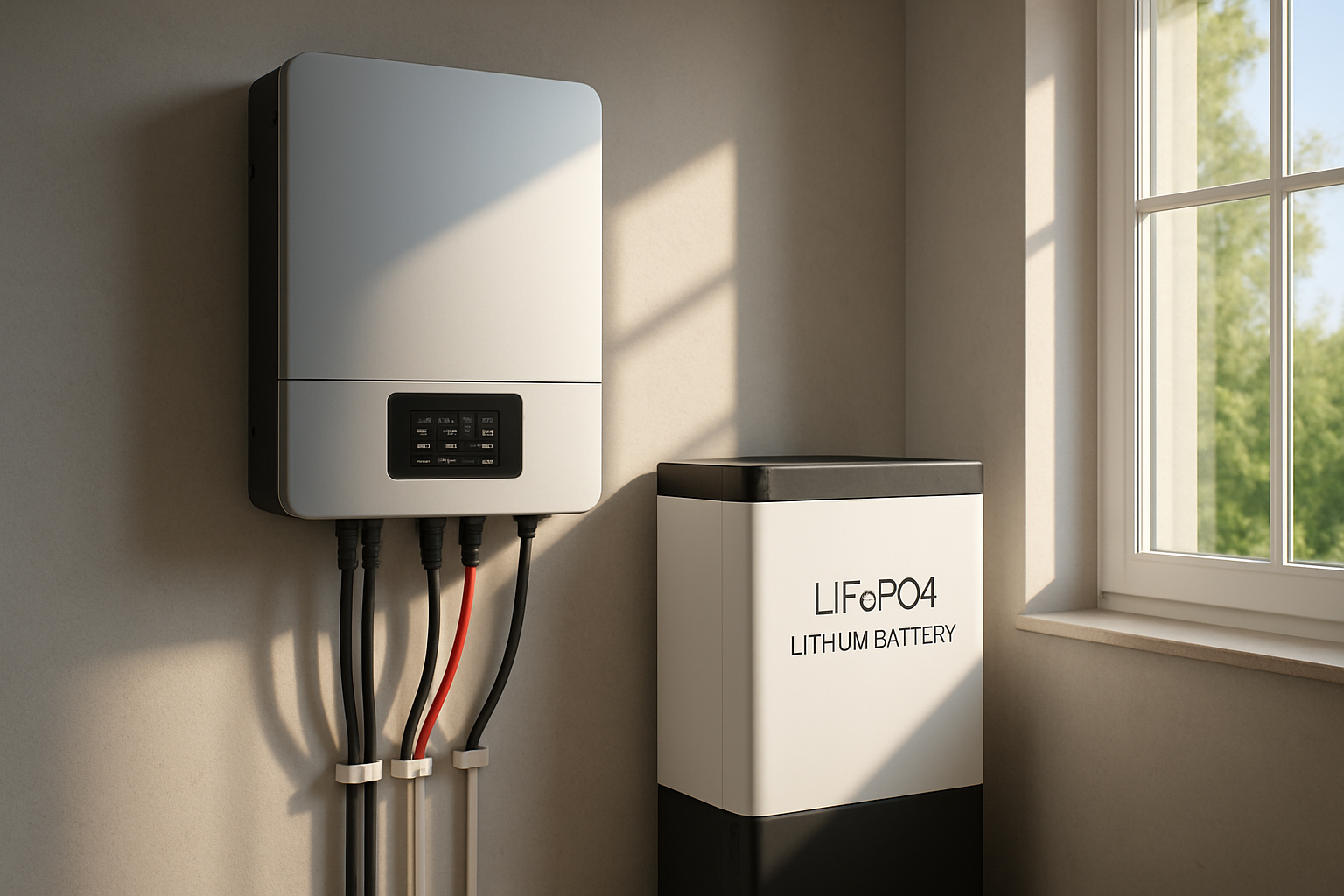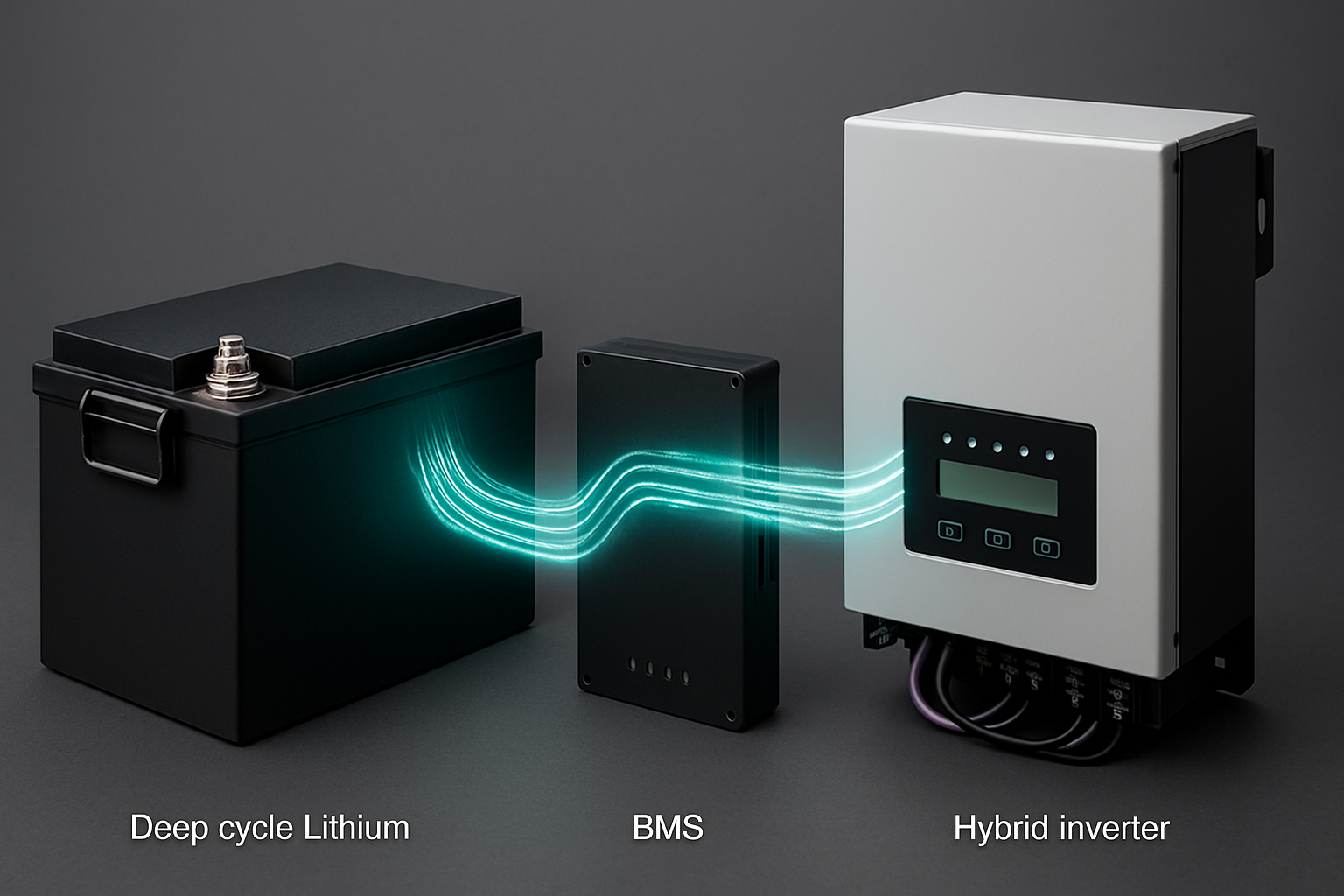Selecting the right inverter is a critical decision for any home battery system. This component acts as the brain of your solar setup, managing the flow of energy between solar panels, batteries, and your home. The choice between a hybrid inverter and a standard inverter directly impacts your system’s efficiency, scalability, and overall cost. Understanding the key differences will help you build a reliable and effective solar energy storage system.
Understanding the Core Components
At its core, an inverter's primary job is to convert the direct current (DC) electricity generated by solar panels into alternating current (AC) that powers your home appliances. However, the way different inverters handle this process, especially with battery storage, sets them apart.
The Role of a Standard Inverter
A standard inverter, often called a string or grid-tie inverter, focuses on one main task: converting DC to AC for immediate use. Any excess energy produced is sent back to the utility grid. If you want to add a home battery system to a setup with a standard inverter, you'll need additional components, such as a separate battery inverter and a charge controller, to manage the energy flowing into and out of the battery. This can add complexity and potential points of failure to the system.
The Emergence of the Hybrid Inverter
A hybrid inverter is an all-in-one solution that combines the functions of a solar inverter and a battery inverter into a single unit. It intelligently manages power from your solar panels, solar batteries, and the grid simultaneously. This integrated approach simplifies installation, reduces the number of components, and often improves overall system efficiency. A hybrid controller inverter combination is designed from the ground up to work with a home battery storage system, making it a future-proof choice for homeowners aiming for energy independence.
Key Differences: A Head-to-Head Comparison
When you compare a hybrid vs. standard inverter, the distinctions become clear in system design, energy management, and cost.
System Design and Complexity
A standard inverter setup with batteries is inherently more complex. It involves separate devices for power conversion and battery management, which means more wiring and installation labor. In contrast, a hybrid inverter streamlines the entire system. This integrated design not only saves physical space but also simplifies monitoring and maintenance. According to a report by the International Renewable Energy Agency (IRENA), the trend in modern power systems is towards integrated and smart components, like hybrid inverters, which can provide grid stability services. As detailed in the Grid Codes for Renewable Powered Systems publication, these advanced inverters are crucial for managing variable renewable energy sources.
Efficiency and Energy Management
Efficiency is a major advantage of hybrid inverters. In a standard system with an added battery (an AC-coupled system), power undergoes multiple DC-to-AC and AC-to-DC conversions, leading to energy loss at each step. A hybrid inverter (a DC-coupled system) allows solar energy to charge the battery directly in DC, minimizing conversion losses and maximizing the amount of stored energy available for use. Modern hybrid inverters can achieve conversion efficiencies exceeding 95%, ensuring minimal energy is wasted.
Cost Considerations: Upfront vs. Long-Term
Initially, a standard inverter is less expensive than a hybrid model. However, if you plan to add a battery, the total cost can quickly escalate with a standard setup because you must purchase a separate battery inverter or charger. A hybrid inverter may have a higher upfront cost, but it can be more economical in the long run by eliminating the need for extra components and offering greater efficiency. This integrated approach provides better long-term value, especially in areas with time-of-use electricity rates where you can maximize savings by using stored energy during peak hours.
| Feature | Standard Inverter System | Hybrid Inverter System |
|---|---|---|
| Core Function | Converts DC to AC for immediate use or grid export. | Converts DC to AC, manages battery charging/discharging, and interacts with the grid. |
| Battery Integration | Requires a separate battery inverter and charge controller (AC-coupled). | Directly connects to batteries (DC-coupled), all-in-one unit. |
| System Complexity | Higher; more components and wiring. | Lower; streamlined and integrated design. |
| Efficiency | Lower due to multiple power conversions, resulting in energy losses. | Higher; direct DC-to-DC charging from panels to battery minimizes losses. |
| Upfront Cost | Lower for the inverter alone, but higher total cost if adding batteries later. | Higher for the inverter, but often lower total system cost for solar-plus-storage. |
| Backup Power | Typically does not provide backup power during outages without additional hardware. | Seamlessly switches to battery power during grid outages. |
Why a Hybrid Controller Inverter Combination Excels with Lithium Batteries
The choice of inverter is particularly important when using advanced battery chemistries like Lithium Iron Phosphate (LiFePO4).
Optimizing LiFePO4 Battery Performance
LiFePO4 batteries, such as a 12v 100ah lithium ion battery, offer long cycle life and high efficiency but require precise management. A hybrid inverter is designed with sophisticated battery management systems that communicate directly with the battery’s own BMS. This ensures optimal charging and discharging cycles, protecting the deep cycle lithium battery from stress and extending its lifespan. As noted in the U.S. Department of Energy's research, advanced power electronics are key to boosting the overall efficiency of solar systems. The principles discussed in their work on improving photovoltaic module performance underscore the value of integrated and intelligent components like hybrid inverters.
Seamless Integration for Energy Independence
A hybrid inverter is the cornerstone of a true solar energy storage system. It allows you to maximize self-consumption of your solar power, storing excess energy in your lithium battery storage for use at night or during cloudy days. This reduces your reliance on the grid and provides a reliable backup power source during outages. For those building off-grid solar solutions, a hybrid inverter is an indispensable component for managing power in a self-sufficient system. The International Energy Agency highlights in its Clean Energy Innovation report that home battery storage is a key technology for empowering consumers and reshaping energy systems.
Making the Right Choice for Your Home
Your decision should align with your current energy needs and future goals.
Scenarios Favoring a Standard Inverter Setup
If you have no immediate plans to add battery storage and your primary goal is to reduce your electricity bill with a grid-tied system, a standard inverter is a cost-effective choice. It’s a straightforward solution for harnessing solar power during the day. You can always retrofit a battery later using an AC-coupled solution, though it may be less efficient.
When a Hybrid Inverter is the Clear Winner
A hybrid inverter is the superior choice if you want battery storage now or in the future. It is ideal for homeowners who want to achieve greater energy independence, ensure backup power during outages, or take advantage of time-of-use utility rates. For anyone serious about building a comprehensive home battery storage system with a lithium phosphate battery, the integrated design and higher efficiency of a hybrid inverter offer unmatched performance and value. For more on maximizing system output, the ultimate reference for solar storage performance provides valuable data on how matched components lead to better results.
A Forward-Looking Perspective
Choosing between a standard and hybrid inverter is about more than just current needs; it's about preparing for the future of energy. A hybrid inverter provides the flexibility to adapt as your energy requirements change or as new battery technologies emerge. By opting for a hybrid controller inverter combination, you are investing in a smarter, more resilient, and more efficient home energy system capable of delivering true energy independence.
Frequently Asked Questions
Can I add a battery to my existing solar system with a standard inverter?
Yes, you can add a battery to an existing system with a standard inverter. This is typically done through 'AC coupling,' where a separate battery inverter is added. While this is a viable retrofit option, it is generally less efficient than a DC-coupled system with a hybrid inverter due to the extra power conversions.
Is a hybrid inverter more expensive?
The upfront cost of a hybrid inverter is typically higher than a standard inverter. However, when you factor in the cost of adding a separate battery inverter and charge controller to a standard system, the total cost for a battery-ready system is often comparable or even lower with a hybrid solution.
What is the lifespan of a hybrid inverter?
A quality hybrid inverter typically has a lifespan of 10 to 15 years, often accompanied by a warranty of 5 to 12 years. The lifespan can be influenced by factors like operating conditions, temperature, and maintenance. Choosing a reputable manufacturer with a strong warranty is important for long-term reliability.





Leave a comment
All comments are moderated before being published.
This site is protected by hCaptcha and the hCaptcha Privacy Policy and Terms of Service apply.